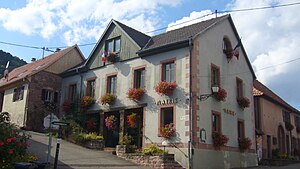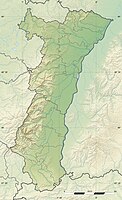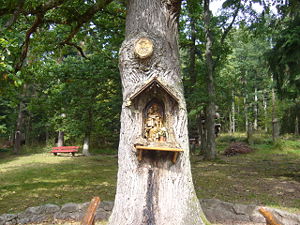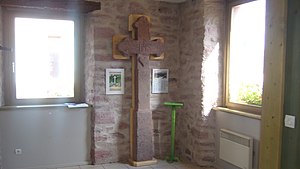 Mairie | ||
| Thannenkirch | ||
| department | Haut-Rhin | |
|---|---|---|
| Residents | 465 (2018) | |
| height | 476 | |
| no value for height on Wikidata: | ||
| Tourist info | 33 (0)3 89 73 23 23 http://www.ribeauville-riquewihr.com | |
| no tourist info on Wikidata: | ||
| location | ||
| ||
Thannenkirch is a small village surrounded by meadows and forests FrenchAlsace and member of the association of Pays de Ribeauvillé and Riquewihr.
The village is on the D 42 and D 481 between Bergheim in the south Lièpvre in the northern Bas-Rhin.
background
.svg/200px-Blason_ville_fr_Thannenkirch_(Haut-Rhin).svg.png)
location
The place is at the foot of the TaennchelMountain range with the highest elevation Le Ramelstein (988 m) and was named in 1997 as Verte station ("Green Resort") classified. The location of the place offers an excellent view of the Upper Rhine Plain and the mountain ranges of the Black Forest.
Something about the story
The legend tells that in the 10th century a hermit settled near a spring and under a huge fir tree and built a chapel, which he dedicated to St. Anne. Bit by bit, forest workers and charcoal burners from Lorraine settled here. The episcopal archives of Basel show a chapel with the name here Templum Sanctae Annae supra Berkem ("Sankt-Anna-Kapelle above Bergheim"). In the 12th to 13th centuries, the place belonged to the lordship of Rathsamshausen, an Alsatian noble family that belonged to a castle that has since fallen down Sélestat resided. Since then the place has had different names: Thankilch up to 1280, D'Annakerich, then from 1320 to 1626 Tannenkilch, Dannenkilch, Dannekilch, Annakilch, Sankt-Annakirch and finally, since the Thirty Years War, Thannenkirch. In 1470 the place fell as a fief to the House of Ribeaupierre in Ribeauvillé, in the Thirty Years War (1618-1648) almost all the inhabitants left the place, which was then repopulated by the influx of foreigners. At the beginning of the 19th century, the most important income for the residents was the income from the timber and coal industry and animal breeding. With the advent of industrialization and the boom in the textile industry in just 10 km away Lièpvre Thannenkirch also achieved modest prosperity with artisanal textile processing. In 1924 the place received the status as an air health resort for lung patients, similar to, but later than Aubure. During the Second World War, the Nazis renamed the place by omitting the h after the T, which led to some confusion with the postal delivery, because there was a place of the same name in Baden. Since 1958 it has been called again like today: Thannenkirch.
The crest
Blazon: (Source: Book of arms of the municipalities in Haut-Rhin from 1981)
- parti: au premier d'argent au sapin de sinople, futé et arraché de sable, au second de gueules au portail d'église d'or, ouvert et ajouré du champ, sur une terrasse de sinople.
- Prose translation (not exactly heraldic): "First a green fir tree on silver, with a black and torn trunk, then a golden church, open and broken by the field, on a green background"
- The coat of arms represents the two eponymous objects, fir tree and church.
getting there
By plane
The nearest commercial airports are the Strasbourg airport![]() (IATA: SXB), 55 km and the EuroAirport Basel-Mulhouse-Freiburg
(IATA: SXB), 55 km and the EuroAirport Basel-Mulhouse-Freiburg![]() (IATA: BSL, MLH, EAP), 81 km.
(IATA: BSL, MLH, EAP), 81 km.
The Colmar-Houssen airfield (16 km away) allows the landing of small private planes.
By car
The journey takes place by car
- from north and south over the
 Alsacienne auto route, N 83,
Alsacienne auto route, N 83,  18 Ostheim, then about the D 1 up and D 6 in the town center.
18 Ostheim, then about the D 1 up and D 6 in the town center. - from the west from inland (Sainte-Croix-aux-Mines) about the N 59 to Lièpvre and D 481 to the department border, then on the one that is now called D 42 and the D 1bis via Saint-Hippolyte, from there directly into town.
- from the east: The next Rhine crossing to Germany is at Marckolsheim (24 km)
By train
The place does not have a train station. The nearest train station with a TGV stop is in Sélestat.
By bus
A 109 bus connects Colmar every 4 hours. There is no bus connection to Sélestat, you take the same bus line to Colmar and then the train to Selestat.
mobility

The place is not surrounded by vineyards like many others in the region, but by meadows and forests. The main road Rue Sainte-Anne runs in a few turns through the place, whereby it also has upward and downward gradients.
Tourist Attractions

When visiting the place you should pay attention to the many guild signs, years of construction and initials of the house owner, which can usually be seen on the lintel of the house entrance or in the zenith of arches, which are not discussed in detail below. It means:
- A hammer, crossed with two clamps: the cooper (coopers)
- The merchant shows a "4" representing the 4 sails of a ship transporting goods
- The winemaker has a vine knife (Cerpette) as a guild symbol
- A star is the symbol of the sworn "wine connoisseur", a mediator between winemakers and wine dealers or consumers (wine commission agent).
- The farrier shows a horseshoe surrounding a hammer, which in turn is crossed by pliers
- The carpenter has nails and a saw in the guild mark
- A plane stands for the carpenter
- A swastika looks like a swastika, but its meaning is controversial
On the D 42 of Bergheim Coming, there is a sharp right bend shortly before the start of the village, at the apex of which a path turns left that leads to a parking lot after 100 m, where you can start a site visit. The first sight is also right across the street in the field.
- 1 Croix des rogations - The supplicant's cross dates from 1814, when, in the three days before Ascension, supplication processions went through the town, asking for divine blessings for fields and fields.
The next point is one of the town's nine wells that supplied it with crystal clear water. Some fountains are decorated by a local wood carver. The fountains are decorated for Easter.
- 2 Fontaine - This fountain consists of a sandstone block from the Thaennchen massif.
- 3 École - This is where the first school in the town, whose first teacher is mentioned in documents from 1629, was Christoph de Remiremont.
- 4 Église Sainte-Cathérine - Sankt Katharina-Kirche: The foundation stone was laid on May 3, 1769 for the church of the then 800-strong community. In 1898 the bell tower, sacristy and nave were expanded to accommodate the church, which had become too narrow. Similar to that Église Saint-Jacques-le-Majeur in Hunawihr the tower clock only has an hour hand.
- The choir of the church holds some art treasures, such as a statue of St. Anna; a 1955 wedding bench created for the wedding of André Bosshardt, the artist of some of these works of art; Relief pictures showing the empty tomb of Christ and the episode of the Brazen snake of Moses and others; former communion pews decorated with biblical scenes
- The nave also has a lot to offer: a wood-carved cloister by the same artist; two wooden relief pictures from the 18th century depicting St. Wendelin as an animal rights activist, Sainte-Odile (patron saint of Alsace) and St. Augustine.
- The organ, at least the prospectus, from 1836 comes from the workshop of Claude-Ignace Callinet.
- 5 Mairie - The town hall, remodeled in 1996, directly opposite the church, dates from 1824. The two columns in the entrance portal are remarkable, depicting the employment of the Thannenkircher. Inside there is a stone cross that was once placed on the museum Gallows Mountain has stood.
- 6 Fontaine - The spring bubbles to the surface below the house wall. The statue of St. Anna and St. Virgin stands like a corner pillar on the corner of the house and is decorated with pine cones and cherries.
- 7 sanatorium - Sanatorium: The building was built in 1924 to accommodate people with lung disease and tuberculosis (see also: Aubure).
- 8 Croix - This cross stands where the criminals once went to the gallows. The current cross is from 1945. The previous cross was overrun by tanks in 1944 and is now in the town hall.
- 9 Fairground - At the fairground a fountain can be seen, which is decorated with a bouquet girl.
- At the exit to the left of the Route du Haut-Koenigsbourg there is a 100-year-old oak in which a carving was incorporated in 1952 showing the Mother of God with her child. This work will Oratoire Notre-Dame-des-Bois called. Since the oak is living wood, the work has to be renewed regularly, most recently in 2002 (status 2015). Right next to it is a fountain made of Thaennchel sandstone.
- At the Rue du Thaennchel you can find the Thaennchelbrunnen between the Chemin du Brunnmatten and the Chemin du Schillig, which served as a cattle trough and washing area until the 1970s
- 10 Lumberjack Fountain - The lumberjack fountain from 1906 with a sculpture reminiscent of the work of the forest workers.
activities
- The place is ideal as a starting point for trips to Strasbourg, Sélestat, Haut-Koenigsbourg (only a few km away) and in the other places of the Community association.
- Somewhat outside of the local area you can go to the Grasberg walk, where you can also find the German military cemetery. If you want to come here by car: In Bergheim there is a junction from the road to Rorschwihr, the Grasbergweg leads to a parking lot, from which you have to walk about 150 m to the cemetery.
shop
There is little or no shopping opportunity for everyday goods, everything is available in the larger neighboring towns, mainly in the nearby one Sélestat.
kitchen
There are many in a typical Alsatian wine town like this one Winstubswhich offer small, regional dishes in addition to wine. Restaurants can be found in the neighboring communities.
Here are two restaurants that are also offered on the Tourist Information website:
- 1 Auberge la Meunière, 30, rue Saint Anne, 68590 Thannenkirch. Tel.: 33 (0)389 73 10 47, Email: [email protected].
- 2 Auberge le Melkerhof restaurant, 10 lieu-dit 'Le Melkerhof', 68590 Thannenkirch. Tel.: 33 (0)389 73 13 09, Email: [email protected]. - Game dishes depending on the season, pikeperch fillet with sauerkraut, pork knuckle.
- See also: Alsatian cuisine at Koch-Wiki
accommodation
- 2 Auberge la Meunière, 30, rue Saint Anne, 68590 Thannenkirch. Tel.: 33 (0)389 73 10 47, Email: [email protected].
Work
security
health
Emergency numbers
Please refer Emergency numbers in France
Practical advice
The place does not have its own post office.
trips
The place is an ideal starting point in the other very beautiful villages of the community association, in the Vosges, to the nearby castle ruins Haut-Koenigsbourg and to Colmar.
literature
Individual references and sources
- Tourist information brochure (also in German)









